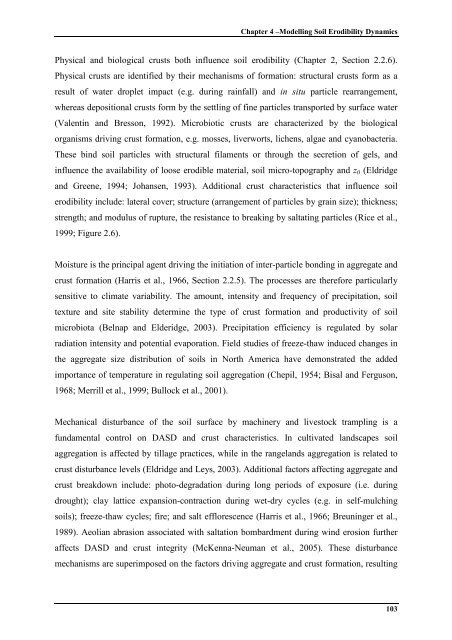Wind Erosion in Western Queensland Australia
Modelling Land Susceptibility to Wind Erosion in Western ... - Ninti One
Modelling Land Susceptibility to Wind Erosion in Western ... - Ninti One
Create successful ePaper yourself
Turn your PDF publications into a flip-book with our unique Google optimized e-Paper software.
Chapter 4 –Modell<strong>in</strong>g Soil Erodibility DynamicsPhysical and biological crusts both <strong>in</strong>fluence soil erodibility (Chapter 2, Section 2.2.6).Physical crusts are identified by their mechanisms of formation: structural crusts form as aresult of water droplet impact (e.g. dur<strong>in</strong>g ra<strong>in</strong>fall) and <strong>in</strong> situ particle rearrangement,whereas depositional crusts form by the settl<strong>in</strong>g of f<strong>in</strong>e particles transported by surface water(Valent<strong>in</strong> and Bresson, 1992). Microbiotic crusts are characterized by the biologicalorganisms driv<strong>in</strong>g crust formation, e.g. mosses, liverworts, lichens, algae and cyanobacteria.These b<strong>in</strong>d soil particles with structural filaments or through the secretion of gels, and<strong>in</strong>fluence the availability of loose erodible material, soil micro-topography and z 0 (Eldridgeand Greene, 1994; Johansen, 1993). Additional crust characteristics that <strong>in</strong>fluence soilerodibility <strong>in</strong>clude: lateral cover; structure (arrangement of particles by gra<strong>in</strong> size); thickness;strength; and modulus of rupture, the resistance to break<strong>in</strong>g by saltat<strong>in</strong>g particles (Rice et al.,1999; Figure 2.6).Moisture is the pr<strong>in</strong>cipal agent driv<strong>in</strong>g the <strong>in</strong>itiation of <strong>in</strong>ter-particle bond<strong>in</strong>g <strong>in</strong> aggregate andcrust formation (Harris et al., 1966, Section 2.2.5). The processes are therefore particularlysensitive to climate variability. The amount, <strong>in</strong>tensity and frequency of precipitation, soiltexture and site stability determ<strong>in</strong>e the type of crust formation and productivity of soilmicrobiota (Belnap and Elderidge, 2003). Precipitation efficiency is regulated by solarradiation <strong>in</strong>tensity and potential evaporation. Field studies of freeze-thaw <strong>in</strong>duced changes <strong>in</strong>the aggregate size distribution of soils <strong>in</strong> North America have demonstrated the addedimportance of temperature <strong>in</strong> regulat<strong>in</strong>g soil aggregation (Chepil, 1954; Bisal and Ferguson,1968; Merrill et al., 1999; Bullock et al., 2001).Mechanical disturbance of the soil surface by mach<strong>in</strong>ery and livestock trampl<strong>in</strong>g is afundamental control on DASD and crust characteristics. In cultivated landscapes soilaggregation is affected by tillage practices, while <strong>in</strong> the rangelands aggregation is related tocrust disturbance levels (Eldridge and Leys, 2003). Additional factors affect<strong>in</strong>g aggregate andcrust breakdown <strong>in</strong>clude: photo-degradation dur<strong>in</strong>g long periods of exposure (i.e. dur<strong>in</strong>gdrought); clay lattice expansion-contraction dur<strong>in</strong>g wet-dry cycles (e.g. <strong>in</strong> self-mulch<strong>in</strong>gsoils); freeze-thaw cycles; fire; and salt efflorescence (Harris et al., 1966; Breun<strong>in</strong>ger et al.,1989). Aeolian abrasion associated with saltation bombardment dur<strong>in</strong>g w<strong>in</strong>d erosion furtheraffects DASD and crust <strong>in</strong>tegrity (McKenna-Neuman et al., 2005). These disturbancemechanisms are superimposed on the factors driv<strong>in</strong>g aggregate and crust formation, result<strong>in</strong>g103
















